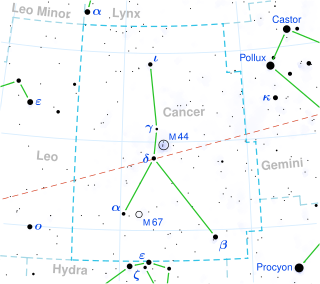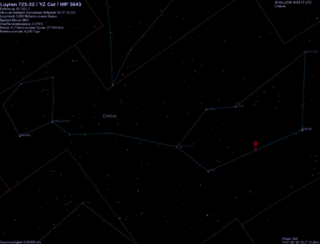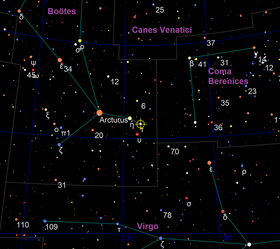
Upsilon Andromedae is a binary star located 44 light-years from Earth in the constellation of Andromeda. The system consists of an F-type main-sequence star and a smaller red dwarf.

Pollux is the brightest star in the constellation of Gemini. It has the Bayer designation β Geminorum, which is Latinised to Beta Geminorum and abbreviated Beta Gem or β Gem. This is an orange-hued, evolved red giant located at a distance of 34 light-years, making it the closest red giant to the Sun. Since 1943, the spectrum of this star has served as one of the stable anchor points by which other stars are classified. In 2006 an exoplanet was announced to be orbiting it.

55 Cancri is a binary star system located 41 light-years away from the Sun in the zodiac constellation of Cancer. It has the Bayer designation Rho1 Cancri (ρ1 Cancri); 55 Cancri is the Flamsteed designation. The system consists of a K-type star and a smaller red dwarf.
Xi Boötis, Latinised from ξ Boötis, is a binary star system located at a distance of 22 light-years away from Earth. It is the nearest visible star in the constellation Boötes. The brighter, primary component of the pair has a visual magnitude of 4.70, making it visible to the naked eye.
HD 93083 is an orange-hued star in the southern constellation of Antlia. It has the proper name Macondo, after the mythical village of the novel One Hundred Years of Solitude. The name was selected by Colombia during the IAU's NameExoWorlds campaign. The star has an apparent visual magnitude of 8.30, which is too faint to be visible to the naked eye. It is located at a distance of 93 light years from the Sun based on parallax. HD 93083 is drifting further away with a radial velocity of +43.65 km/s, having come to within 43 light-years some 484,000 years ago.
HD 208487 is a star with an orbiting exoplanet in the constellation of Grus. Based on parallax measurements, it is located at a distance of 146.5 light years from the Sun. The absolute magnitude of HD 208487 is 4.26, but at that distance the apparent visual magnitude is 7.47, which is too faint to be viewed with the naked eye. The system is drifting further away with a radial velocity of 5.6 km/s. It is a member of the thin disk population.
HD 179949 is a 6th magnitude star in the constellation of Sagittarius. It is a yellow-white dwarf, a type of star hotter and more luminous than the Sun. The star is located about 90 light years from Earth and might be visible under exceptionally good conditions to an experienced observer without technical aid; usually binoculars are needed.
HD 130322 is a star with a close orbiting exoplanet in the constellation of Virgo. The distance to this system is 104 light years, as determined using parallax measurements. It is drifting closer to the Sun with a radial velocity of −12.4 km/s. With an apparent visual magnitude of 8.04, it is too dim to be visible to the naked eye; requiring binoculars or a small telescope to view. Being almost exactly on the celestial equator the star is visible everywhere in the world except for the North Pole. The star shows a high proper motion, traversing the celestial sphere at an angular rate of 0.197 arcsec yr−1.

Tau Boötis b, or more precisely Tau Boötis Ab, is an extrasolar planet approximately 51 light-years away. The planet and its host star is one of the planetary systems selected by the International Astronomical Union as part of NameExoWorlds, their public process for giving proper names to exoplanets and their host star. The process involved public nomination and voting for the new names, and the IAU planned to announce the new names in mid-December 2015. However, the IAU annulled the vote as the winning name was judged not to conform with the IAU rules for naming exoplanets.

YZ Ceti is a red dwarf star in the constellation Cetus. Although it is relatively close to the Sun at just 12 light years, this star cannot be seen with the naked eye. It is classified as a flare star that undergoes intermittent fluctuations in luminosity. YZ Ceti is about 13 percent the mass of the Sun and 17% of its radius.
HD 118203 is a star with an orbiting exoplanet located in the northern circumpolar constellation of Ursa Major. It has the proper name Liesma, which means flame, and it is the name of a character from the Latvian poem Staburags un Liesma. The name was selected in the NameExoWorlds campaign by Latvia, during the 100th anniversary of the IAU.

HD 179949 b, formally named Mastika, is an extrasolar planet discovered by the Anglo-Australian Planet Search at the Anglo-Australian Observatory, which orbits the star HD 179949. The planet is a so-called "hot Jupiter", a Jupiter-mass planet orbiting very close to its parent star. In this case, orbital distance is almost one-tenth that of Mercury from the Sun. One orbital revolution lasts only about 3 days.
BD−17 63 is a K-type main-sequence star in the southern constellation Cetus. It is a 10th magnitude star at a distance of 113 light-years from Earth. The star is rotating slowly with a negligible level of magnetic activity and an age of over 4 billion years.

51 Pegasi b, officially named Dimidium, is an extrasolar planet approximately 50 light-years away in the constellation of Pegasus. It was the first exoplanet to be discovered orbiting a main-sequence star, the Sun-like 51 Pegasi, and marked a breakthrough in astronomical research. It is the prototype for a class of planets called hot Jupiters.
HD 181720 is star with an orbiting substellar companion in the southern constellation of Sagittarius. It is located at a distance of 196 light years from the Sun based on parallax measurements, but is drifting closer with a radial velocity of −45.4 km/s. The star has an absolute magnitude of 4.10, but at that distance it has an apparent visual magnitude of 7.84, which is too faint to be seen with the naked eye. It shows a high proper motion, traversing the celestial sphere at an angular rate of 0.444 arcsec yr−1.
HIP 12961 is a star with an exoplanetary companion in the equatorial constellation of Eridanus. It is too faint to be visible to the naked eye, with an apparent visual magnitude of 10.24. The distance to this system can be estimated from its parallax measurements, which yield a separation of 76.4 light-years from the Sun. It is receding with a radial velocity of +33 km/s and has a high proper motion, traversing the celestial sphere at an angular rate of 0.300″ yr−1.
HD 63765 is a star with an orbiting exoplanet in the southern constellation of Carina. It is too faint to be visible with the naked eye, having an apparent visual magnitude of 8.10. The distance to this system is 106 light years based on parallax measurements, and it is drifting further away with a heliocentric radial velocity of 22 km/s.
HD 7199 is a star in the constellation Tucana located 118 light years distance from the Sun based on parallax. It has an orange hue but is too dim to be viewed with the naked eye, having an apparent visual magnitude of +8.06. The star is drifting further away from the Sun with a radial velocity of +5.6 km/s.

Gliese 486, also known as Wolf 437 and formally named Gar, is a red dwarf star 26.4 light-years away in the constellation Virgo. It hosts one known exoplanet.








